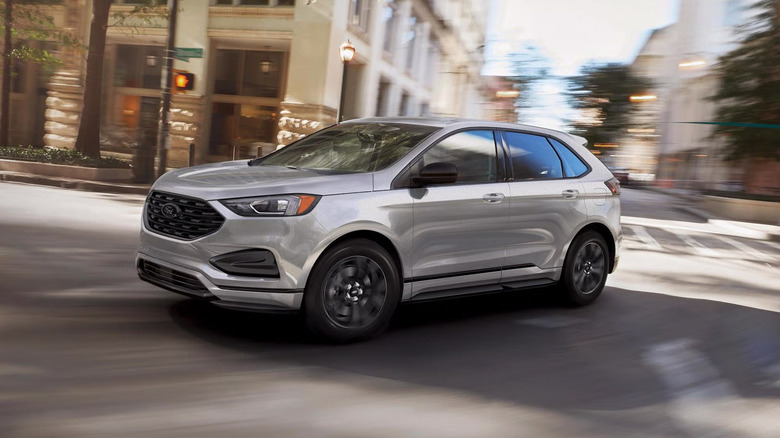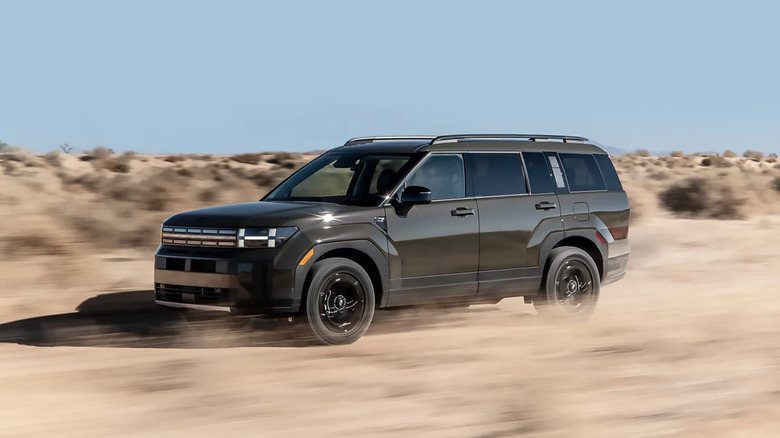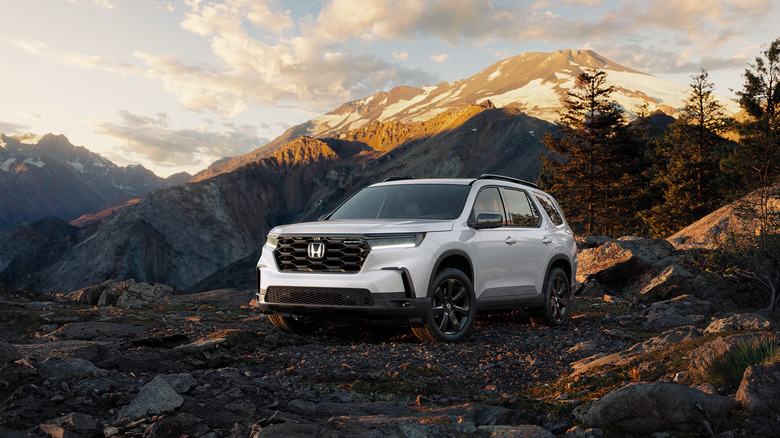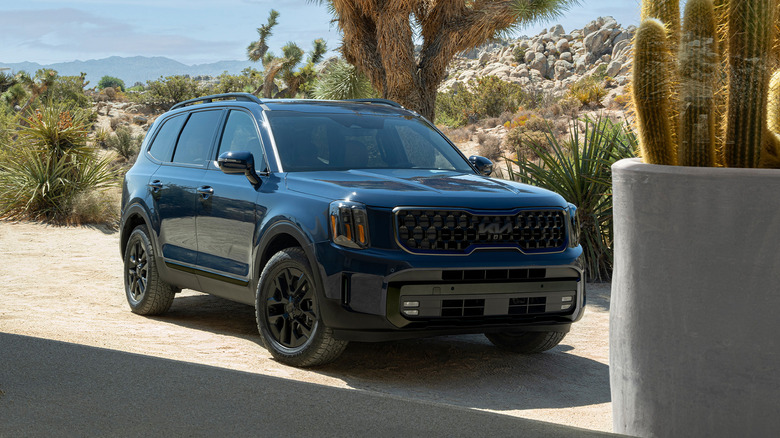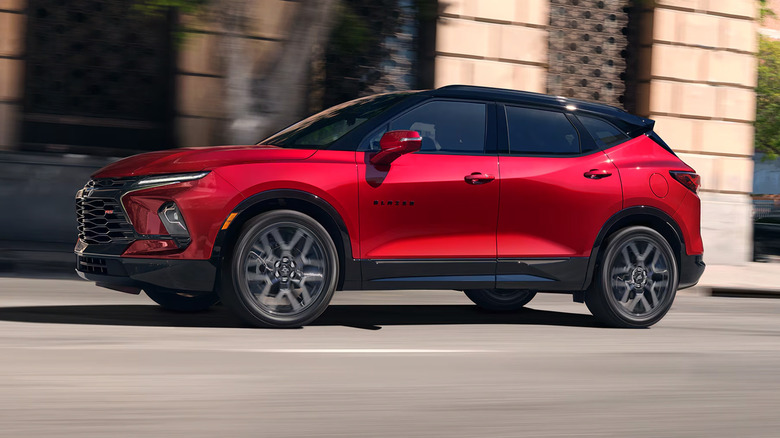5 Of The Best Ford Edge Alternatives
When it comes to the most practical American manufacturers, very few can hold their own against Ford. The best-selling brand to come out of the States throughout 2024, slightly ahead of Chevrolet, Ford offers an array of top-quality large vehicles you'd expect from a brand with so much authority in the market. With an SUV of almost any size in 2025, the lineup did get smaller this year, thanks to the discontinuation of the Ford Edge. The Explorer is now the sole remaining mid-size SUV, leading the charge in one of the industry's most competitive segments.
As is the case for many nameplates, the Ford Edge was discontinued last year as part of a production reshuffle. By only leaving the lineup last year, the 2024 Edge still more than holds up in most areas, particularly with its 2.0-liter inline-four producing 250 horsepower and 280 pound-feet of torque, with all-wheel drive as standard. Its efficiency is also respectable for a non-hybrid mid-size SUV at 22 MPG combined. Pricing for the 2024 Edge comes in at an average of $37,002, keeping in touch with the models still in production.
While the Edge certainly shouldn't be pushed aside just because it's not in production anymore, various major manufacturers still have attractive models in production that once rivaled the Ford. Coming in at similar price tags and with competitive specs all around, these five SUVs should be near the top of your list if you're in the market for a new mid-size SUV.
2025 Hyundai Santa Fe
The Ford Edge may have run its course, but one of its long-standing rivals is still competing at the top of the mid-size SUV segment. Even more so in 2025 after its major refresh last year, the Hyundai Santa Fe is easily one of the best offerings from the South Korean automaker this year; the mid-size model even manages to creep into full-size numbers in some areas. There's also the mid-size Palisade that shouldn't be written off completely, but the Santa Fe comes in at a notably lower price point without sacrificing much across the board.
In true Hyundai fashion, finding a model in this area that offers better value for money is hard. Starting at $34,300, excluding destination charges, the 2025 Santa Fe is just over $2,000 cheaper than what the latest Ford Edge goes for on the used market. Starting with its performance, the turbocharged 2.5-liter inline-four keeps the SUV well in the mix, producing a solid 277 horsepower and 311 pound-feet of torque. You also shouldn't have to spend any more on fuel compared to the Edge, with the EPA giving the 2025 Santa Fe a rating of 24 MPG combined.
The Santa Fe is also one of the few alternatives to the Ford Edge to offer three rows of seating as standard, giving it even more points over the outgoing American. The Edge does offer decent cargo space, but it can't match the Hyundai's higher 79.6 cubic feet behind the front row.
2025 Toyota Highlander
With Toyota's seemingly endless fleet of cars and SUVs on sale in 2025, it's no surprise that the Japanese brand competes at the front end of the mid-size segment. There are a few different models for each size of the SUV scene to choose from in the current fleet, with the Toyota Highlander being the most affordable mid-size. Hitting dealerships for the first time in 2001, the Highlander has been no stranger to upholding Toyota's reputation for building dependable, practical cars, as is the case in 2025.
The base 2025 Highlander starts at $40,320 (excluding the $1,495 destination charge), closer to the 2024 Edge's starting MSRP than the likes of the Santa Fe. Still, this Toyota does a solid job of earning its more premium price tag, particularly against the Edge. Hiding under the shell is a turbocharged 2.4-liter four-cylinder producing 265 horsepower and 310 pound-feet of torque, well within reach of the more powerful models on this list. The slight decrease in power is made up for through efficiency with a rating of 25 MPG from the EPA.
Three rows of seating come as standard, which, while not quite as spacious as the more expensive Grand Highlander, gives it another one-up over the Ford Edge to become a more attractive alternative. Despite not having as much room in the back, you still get 84.3 cubic feet of cargo space behind the first row.
2025 Honda Pilot
Toyota isn't the only manufacturer keeping Japan at the top of the industry — Honda deserves just as much credit for offering quality cars in all segments. Typically, Honda's price points are a little above the likes of Toyota, but in the case of the Pilot SUV, there is not a noticeable difference relative to other nameplates. Honda doesn't offer a full-size SUV in 2025; instead, it will give us two different models to choose from. The Pilot is the cheaper and larger option than the Passport, offering reliability to rival Toyota's best.
Despite its price tag being higher than some other models in this list, it's still very much there or thereabouts with its MSRP of $40,200 (plus a $1,450 destination charge). You get your money's worth in multiple areas, however, particularly with its 3.5-liter V6 producing a solid 285 horsepower and 262 pound-feet of torque. Its efficiency comes in at 22 MPG combined as per the EPA; not as high as some rivals, but still only slightly below the 2024 Edge.
Looking inside, Honda equips the 2025 Pilot with plenty of technology, particularly on the safety side, thanks to the Honda Sensing system. Further back, the automaker offers two different measurements for the maximum cargo space. Using the SAE J1100 guidelines, the Pilot has 87 cubic feet of volume, but using the J1100 plus metrics, which considers the floor space between seats, the space is boosted to 111.8 cubic feet.
2025 Kia Telluride
At face value, it can be quite difficult to decide whether you should buy a Hyundai or a Kia, as the former supplies quite a few different components to the brand it holds 34% ownership of. Kia takes on a sportier aesthetic for almost every model to give its cars their own identity. Still practical and filled with technology like Hyundai's cars, a Kia could be a great choice if you'd prefer a little more aggression over sophistication. In the mid-size segment, the Telluride remains the premium choice compared to the Sorento, becoming another.
It's no surprise to see the 2025 Kia Telluride share an engine with its Hyundai counterpart, that being the Palisade in this case. Another alternative to the Ford Edge that features a V6, the 3.6-liter engine under the hood of the 2025 Telluride produces 291 horsepower and 262 pound-feet of torque. Efficiency does take a hit slightly due to its larger engine, however, at 22 MPG combined. However, this still keeps it in the same range we'd expect a non-hybrid mid-size SUV to achieve. The latest Telluride can be picked up for $36,390, along with a $1,395 destination charge.
The Telluride's competitiveness carries on inside the cabin, with a cargo volume of 87 cubic feet making it one of the most practical alternatives for maximum space. A third row also comes as standard. Its technology systems also outclass a handful of rivals, with a 12.3-inch display being the hub for the infotainment.
2025 Chevrolet Blazer
The only American alternative to make it onto our list is the Chevrolet Blazer, which has been a staple nameplate in the Detroit-based manufacturer's lineup for decades. While several models have been discontinued between now and its 1969 release date, the Blazer has stood tall as it does in 2025. The mid-size SUV segment receives much attention from American manufacturers, and Chevrolet offers one of the best, even more so now that the Edge has been discontinued.
Not to be confused with the Blazer EV, the gas-powered model starts at a price tag of $35,600 with a $1,495 destination charge, making it another alternative to the Edge that's cheaper than the Ford on the used market currently. With its lower price tag, especially when put next to the other models here, it does struggle to match them in certain areas. Powered by a 2.0-liter four-cylinder engine as standard, the base Blazer produces 228 horsepower and 258 pound-feet of torque. However, if you go for the 3LT trim and select the available 3.6-liter V6, power is boosted to an ultra-competitive 308 horsepower and 270 pound-feet of torque. For this specific setup, pricing starts at $41,495, including the mentioned destination charge.
If you'd rather save money to forego performance, you'll get better efficiency, with the 2.0-liter engine offering 25 MPG combined against the V6's 22 MPG (which is still solid). Cargo space does trail, however, with the Blazer only managing up to 64.2 cubic feet of volume.
